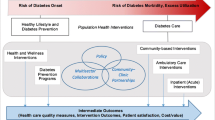Abstract
In this article, we review the reduction in healthcare costs associated with a health maintenance organization (HMO)-sponsored diabetes disease management program in Pennsylvania, USA. The program emphasizes primary care-based nurse education and case management of patients with diabetes mellitus. We found participants in the program experienced a slight increase in health insurance claims related to diabetes care but a notable decrease in total healthcare claims, with a return on investment that exceeded $US3 saved for every dollar expended. The changes we observed appeared within a year of program entry, and were sustained on a month-to-month basis.
Other potential competitive advantages for our HMO created by our disease management programs include a decreased variation in month-to-month costs, greater physician loyalty, and greater local marketplace recognition of quality.
While further studies are necessary to truly gauge the overall value of disease management, our data suggest disease management is an important consideration for health insurance companies faced with increasing costs among enrollees with diabetes mellitus.



Similar content being viewed by others
References
Ellrodt G, Cook DJ, Lee J, et al. Evidence-based disease management. JAMA 1997; 278: 1687–92
Matheson D, Robinson T. Disease management takes flight [online]. Boston Consulting Group. Available from URL: http://www.bcg.com/publications/files/disease-management_taxes_flight_oct_od.pdf [Accessed 2003 Jul 28]
Bodenheimer TS, Grumback K. Capitation or decapitation: keeping your head in changing times. JAMA 1996; 276: 1025–31
Mazze RS, Etzwiler DD, Strock E, et al. Staged diabetes management: towards an integrated model of diabetes care. Diabetes Care 1994; 17 Suppl. 1: 56–66
American Diabetes Association. Diabetes 1996 Vital Statistics. Alexandria (VA): American Diabetes Association, 1996
Rubin RJ, Altman WM, Mendelson DN. Health care expenditures for people with diabetes mellitus. J Clin Endocrinol Metab 1992; 78: 809A–12A
Center for Economic Studies in Medicine. Direct and indirect costs of diabetes in the United States in 1992. Alexandria (VA): American Diabetes Association, 1993
Harris MI, Flegal KM, Cowie CC, et al. Prevalence of diabetes, impaired fasting glucose and impaired glucose tolerance in US adults. Diabetes Care 1998; 21: 518–24
American Diabetes Association. Economic consequences of diabetes mellitus in the United States. Diabetes Care 1998; 21: 296–309
Diabetes Control and Complications Trial Research Group. The effect of intensive treatment of diabetes on the development and progression of long-term complications in insulin-dependent diabetes mellitus. N Engl J Med 1993; 329: 977–86
Ohkubo Y, Kishikawa H, Araki E, et al. Intensive insulin therapy prevents the progression of diabetic microvascular complications in Japanese patients with non-insulin dependent diabetes mellitus: a randomized prospective 6 year study. Diabetes Res Clin Pract 1995; 28: 103–17
Abraira C, Colwell JA, Nuttall FQ, et al. Veterans Affairs Cooperative Study on glycemic control and complications in type II diabetes (VA CSDM): results of a feasibility trial. Diabetes Care 1995; 18: 1113–23
Diabetes Control and Complications Trial Research Group. Effect of intensive diabetes management on macrovascular events and risk factors in the Diabetes Control and Complications Trial. Am J Cardiol 1995; 75: 894–903
Vijan S, Hofer TP, Hayward RA: Estimated benefits of glycemic control in microvascular complications in type 2 diabetes. Ann Intern Med 1997; 127: 788–95
Reichard P, Nilsson B-Y, Rosenqvist U. The effect of long-term intensified insulin treatment on the development of microvascular complications of diabetes mellitus. N Engl J Med 1993; 329: 304–9
Krolewski A, Laffel L, Krolewski M, et al. Glycosylated hemoglobin and the risk of microalbuminuria in patients with insulin-dependent diabetes mellitus. N Engl J Med 1995; 332: 1251–5
UK Prospective Diabetes Study (UKPDS) Group. Intensive blood glucose control with sulphonylureas or insulin compared with conventional treatment and risk of complications in patients with type 2 diabetes (UKPDS33). Lancet 1998; 352: 847–53
Gaede P, Vedel P, Larsen N, et al. Multifactorial interventions and cardiovascular disease in patients with type 2 diabetes. N Engl J Med 2003; 348: 383–93
Kenny SJ, Aubert RC, Geiss LS. Prevalence and incidence of non-insulin dependent diabetes. In: Harris MI, Cowie CC, Stern MP, et al., editors. Diabetes in America. 2nd ed. Bethesda (MD): National Institutes of Health, 1995: 47–67
Weingarten SR, Henning JM, Badamgarav E, et al. Interventions used in disease management programmes for patients with chronic illness: which ones work? Meta-analysis of published reports. BMJ 2002; 325: 925–32
Sommers LS, Marton KI, Barbaccia JC, et al. Physician, nurses and social worker collaboration in primary care for chronically ill seniors. Arch Intern Med 2000; 160: 1825–33
Kabasakalian LM, Hassett RM. A nurse-driven, carve-in approach for managing complex chronic conditions. J Clin Outcomes Manage 1999; 6: 26–30
Selby JV, Ray GT, Zhang D, et al. The excess costs of medical care of patients with diabetes mellitus in a managed care population. Diabetes Care 1997; 20: 1396–402
Eastman RC, Javitt JC, Herman WH, et al. Model of complications of NIDDM. I. Model construction and assumptions. Diabetes Care 1997; 20: 725–34
Herman WH, Eastman RC. The effects of treatment on direct costs of diabetes. Diabetes Care 1998; 21 Suppl. 3: C19–24
Testa MA, Simponson DC. Health economic benefits and quality of life during improved glycemic control in patients with type 2 diabetes mellitus: a randomized, controlled double blind trial. JAMA 1998; 280: 1490–6
Sadur CN, Moline N, Costa M, et al. Diabetes management in a health maintenance organization: efficacy of care management using cluster visits. Diabetes Care 1999; 22: 2011–7
Internal communication: The Myers Group. Geisinger Health Plan, Provider Satisfaction Survey, 2002 Project Guide Book
Acknowledgements
The authors received no sources of funding nor have any conflicts of interest directly relevant to the content of this review.
Author information
Authors and Affiliations
Corresponding author
Rights and permissions
About this article
Cite this article
Sidorov, J., Paulick, P. & Sobel, L. What is the Return on Investment Associated with Diabetes Disease Management?. Dis-Manage-Health-Outcomes 11, 565–570 (2003). https://doi.org/10.2165/00115677-200311090-00004
Published:
Issue Date:
DOI: https://doi.org/10.2165/00115677-200311090-00004




